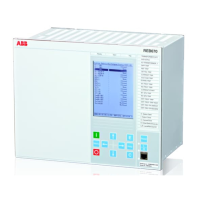optocoupler inputs of the busbar protection. When one phase version of REB670 is
used, then six optocoupler inputs (that is, two in each phase/IED) are required for every
primary switchgear object. For big stations (for example, with 24 bays) this will
require quite a lot of binary inputs into every IED. To limit the number of required
optocoupler inputs into every IED it is possible to use LDCM communication modules
to ef
fectively share the binary Ios between three units, as shown in figure
211211.
<= 192 Binary Signals =>
LD
C
M
#1
LD
C
M
#2
LD
C
M
#1
LD
C
M
#2
LD
C
M
#1
LD
C
M
#2
REB 670, B31
Phase L1
<= 192 Binary Signals =>
<= 192 Binary Signals =>
Wire status of
disconnectors
from Bays 01-08
Wire status of
disconnectors
from Bays 09-16
Wire status of
disconnectors
from Bays 17-24
REB 670, B31
Phase L2
REB 670, B31
Phase L3
en06000198.vsd
IEC06000198 V2 EN-US
Figure 211: Example how to share binary IO between one-phase REB670 IEDs by
using LDCM modules
As shown in figure
211, it is possible to wire only the status for bays 01-08 to A phase-
IED. After that the information about auxiliary contact status for switchgear objects
from these eight bays can be sent via LDCM modules to other two phases. In the
similar way information from other bays can be only wired to
B, respectively C phase
IED and then shared to the other two phases via LDCM communication.
Typical LDCM communication delay between two IEDs is in order of 30-40 ms. Note
that for disconnector status this delay will not pose any practical problems. However,
time delay caused by LDCM communication can be crucial for circuit breakers status.
In such cases it is strongly recommended that at least the circuit breaker closing
command from every circuit breaker is directly wired to all three phases/IEDs to
Section 18 1MRK 505 370-UUS A
Remote communication
494 Busbar protection REB670 2.2 ANSI
Application manual

